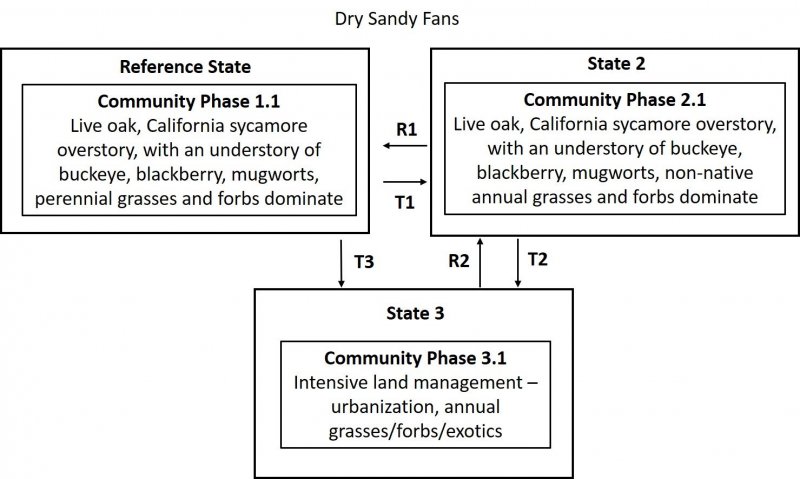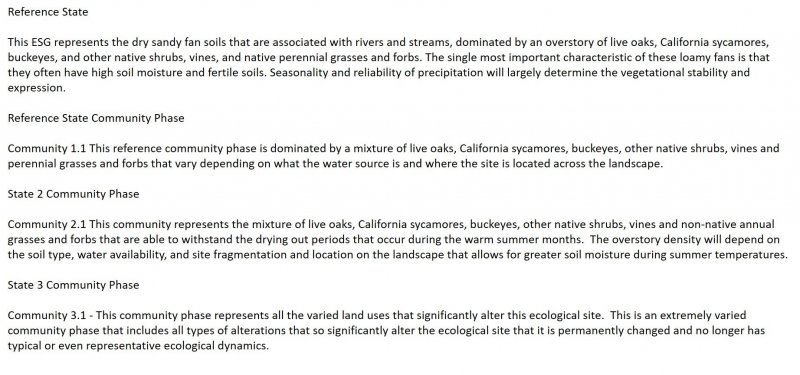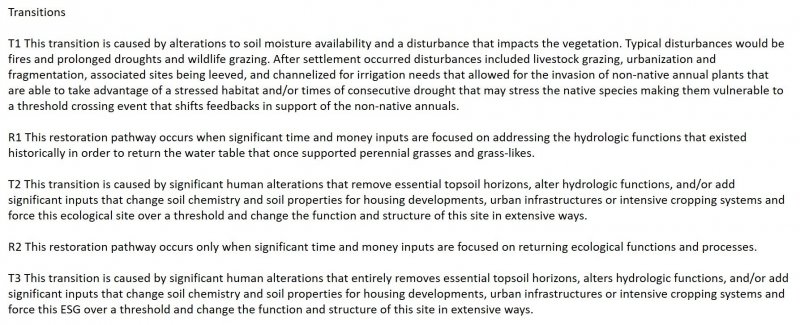Ecological site group R014XG919CA
Dry Sandy Fan
Last updated: 09/07/2023
Accessed: 12/19/2025
Ecological site group description
Key Characteristics
None specified
Provisional. A provisional ecological site description has undergone quality control and quality assurance review. It contains a working state and transition model and enough information to identify the ecological site.
Physiography
This ESG is found primarily on stream terraces, flood plain steps, and alluvial fans with slopes of 0 to 10 percent from 30 to 2100 feet elevations.
Climate
The average annual precipitation in this area is 11 to 53 inches (272 to 1,353 millimeters), this site is on the lower end of the range however. The higher amounts of precipitation occur at the higher elevations in the area north of San Francisco. Most of the rainfall occurs as low- or moderate-intensity, Pacific frontal storms during winter. This area is very dry from midspring to midautumn. Snowfall is rare. The average annual temperature is 54 to 61 degrees F (12 to 16 degrees C). The freeze-free period averages 315 days and ranges from 265 to 365 days. It is longest near the coast, and it becomes shorter with elevation.
Soil features
This ESG is found on variable soils that are generally very deep, moderately well drained to well drained soils in alluvial material from alluvial sources.
Some representative soils include:
Corralitos, a mixed, thermic Typic Xeropsamment
Vegetation dynamics
This ESG covers the areas of the valleys in MLRA 14 that were at one time part of a vast complex of oak savannahs, meadows, and native grasslands. The urbanized landscape in the valleys within this MLRA that exists today makes it difficult to imagine the natural landscape prior to human development. These loamy fans were some of the first areas to be settled and many of these highly fertile and productive ecosystems were drained, leveed, cleared for crops and other agriculture, and urbanized.
As this landscape was de-watered and houses and agriculture took over, the water table for many of these habitats moved deeper and deeper, creating soils that would no longer offer the available soil moisture for many of the plants that had evolved with the hydrologic function of the natural system that no longer existed. These dry sandy fans may have are drier than many of the surrounding soils, due to their rapid permeability and excessive drainage. The variable range in soil textures will dictate the species composition and production, with the finer soils holding more water that results in more native perennials and forbs and higher annual production overall. The coarser textures will dry out more rapidly through both drainage and evapotranspiration in the summer months making them less hospitable for many of the native perennial grasses and more dominated by annual grasses and forbs.
Historically, this site may have been more interconnected to the riparian forests and flood plains, however with the introduction of non-native annual grasses and the impacts from fragmentation, extensive agriculture, channelization of rivers and streams, levees, irrigation ditches, continued de-watering, and human alterations such as homes and roads, this site now reflects a scattered oak savannah with an understory of moderately producing, dry, annual grasslands.
Currently, where this site is not under cultivation or urban developments, it is dominated by non-native annual grasses and scattered overstory of live oaks, California sycamores, buckeyes, other shrubs and vines. These include wild oats, soft chess, ripgut brome, red brome, wild barley, and foxtail fescue. Common forbs include broadleaf filaree, redstem filaree, turkey mullein, true clovers, bur clover, popcorn flower, and many others. Perennial grasses will be found in moist, lightly grazed, or relic prairie areas. Species composition is also related to water availability with greater amounts of relic perennial grasses in areas of greater precipitation or soil moisture.
Information from:
John G. Kie
California Wildlife Habitat Relationships System
California Department of Fish and Game
California Interagency Wildlife Task Group
Major Land Resource Area
MLRA 014X
Central California Coastal Valleys
Stage
Provisional
Click on box and path labels to scroll to the respective text.


